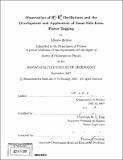Observation of B⁰s - B⁻⁰s oscillations and the development and application of same-side-kaon flavor tagging
Author(s)
Belloni, Alberto, Ph. D. Massachusetts Institute of Technology
DownloadFull printable version (49.00Mb)
Other Contributors
Massachusetts Institute of Technology. Dept. of Physics.
Advisor
Christoph M.E. Paus.
Terms of use
Metadata
Show full item recordAbstract
The search for flavor oscillations in the neutral Bs - B meson system constitutes a flagship analysis of the Tevatron proton-anti-proton collider physics program and an important probe for effects due to new physics beyond the Standard Model of particles and interactions. In particular, the precise measurement of a process such as Boscillations sets a strong constraint on the parameters of quark-flavor mixing in the Standard Model. This dissertation reports the analysis which, for the first time, observed B- Bs oscillations, using data collected with the CDF detector. The sub-percent precision of the measurement is also noteworthy. The data sample used for this analysis includes fully and partially reconstructed Bdecays: ... The focus of this thesis is the algorithm of same-side-kaon tagging which provides _-0 a large fraction of the flavor-tagging power available to this analysis of B- B8 oscillations. Flavor tagging consists in assessing whether a B, meson is creates as a B_--0 or a B, state, and constitutes an important ingredient in the analysis presented in this document. The algorithm which is here described combines particle identification information and kinematic characteristics of the Bevent in an artificial neural network to provide improved tagging power E'2 of about 4.0 - 4.8%, depending on the data sample to which the algorithm is applied. The search for B1 oscillations is performed using an amplitude method based on a frequency scanning procedure. Applying a neural network-based combination of lepton, kaon and jet charge opposite-side tagging algorithms, with a total tagging power of ED2 = 1.8%, and the same-side-kaon tagging algorithm to a data sample of 1 fb-1, a signal of B- B_ oscillations with a significance greater than 5 standard deviations is found ...
Description
Thesis (Ph. D.)--Massachusetts Institute of Technology, Dept. of Physics, 2007. Includes bibliographical references (p. 201-209).
Date issued
2007Department
Massachusetts Institute of Technology. Department of PhysicsPublisher
Massachusetts Institute of Technology
Keywords
Physics.